Let’s chat fermented celery and take a closer look at the art of fermentation today.
Some of the links in this post are affiliate links. This means if you click on the link and purchase the item, I may receive a small commission at no extra cost to you. All opinions remain my own.
Fermentation is one of those “buzzwords” that can often be heard floating around the health and wellness space.
While it may seem complicated, it is actually an incredibly easy process that boosts the nutritional value of food.
In fact, it is so simple it can be set up in your own kitchen in five minutes or less!
Today we will be further exploring this concept with celery, a vegetable absolutely packed with vitamins and antioxidants.
Fermenting celery is a great way to incorporate gut healing into your everyday diet.
It takes hardly any time at all and is perfectly doable with the right supplies and ingredients.
Fermented Celery
Click HERE to save this post for later.
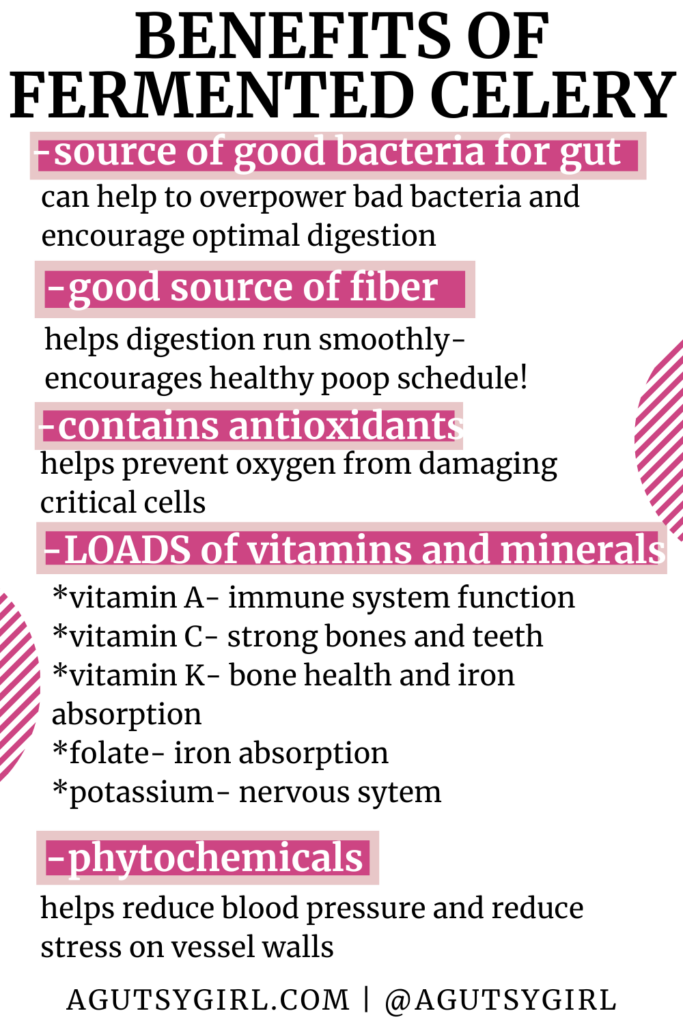
All you need are a few key ingredients:
(Credits to the original recipe HERE)
- 1 bunch of celery
- 1 quart filtered water (I love my AquaTru – save $150 off your own when you use that link)
- 4 teaspoons sea salt
- lemon juice, red pepper flakes, red onion, fresh dill, black pepper (all optional, but all boasting their own gut health and/or general health properties)
And two (main) supplies:
- glass jar
- lid
For fermentation you can use virtually any glass jars with a sealable lid, but like most everything else I ferment, I would recommend a mason jar.
They can be bought in bulk or just individually at most grocery stores or supermarkets.
There are also special fermenting lids that you can purchase that allow you to remove air without physically opening the jar.
A regular lid is also fine as well, it just requires a little extra effort to “burp” the jar. (Not sure what the heck a “burp” is – other than the obvious?! – see below.)
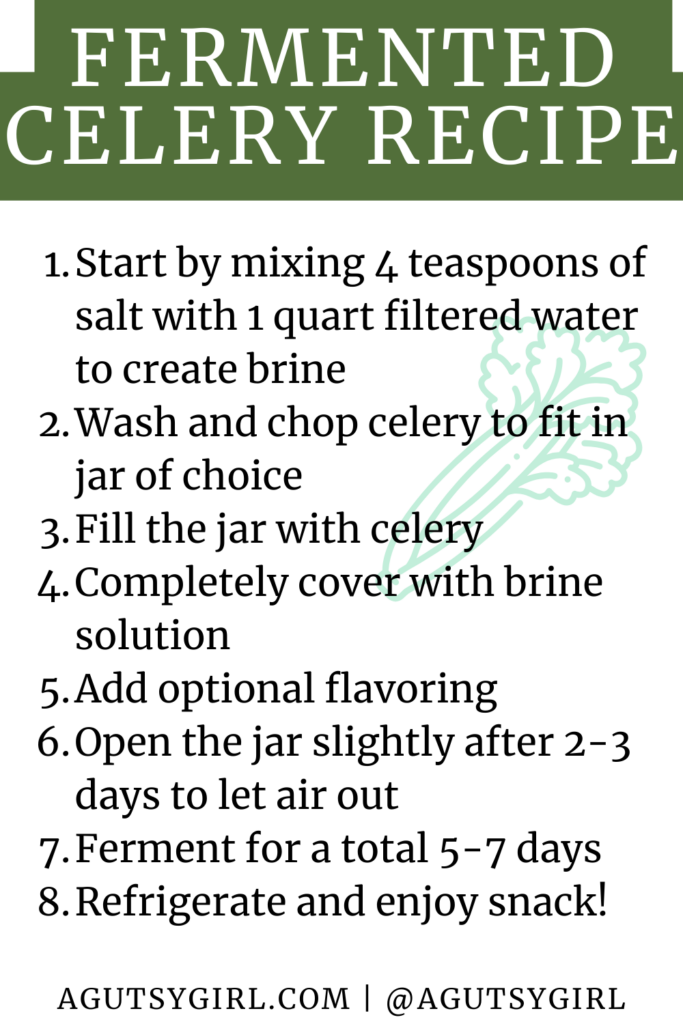
Fermenting Celery Recipe Directions:
- Start by mixing 4 teaspoons of salt with your water and mix thoroughly in a large mixing bowl to create a brine solution.
- Wash and chop celery to fit inside the jar of choice. There should be one inch or more of water between the top of the jar and the celery stalks.
- Fill the jar with celery- keeping them very close together so that they do not float when brine is added. You want to try and reduce the air pockets that could interfere with the fermentation process!
- Completely cover celery with your brine solution.
- Optional to add your lemon juice, pepper flakes, red onion, fresh dill, and/or black pepper.
- Allow to rest for a couple of days in a room cool area with no direct sunlight. A pantry or cabinet is a great place for storing.
- Open the jar slightly to let out air every other day or every day after 2-3 days. This process is also known as “burping” the jar.
- Continue to ferment for a total of 5-7 days. You can ferment longer or a bit shorter depending on taste preference.
- Refrigerate the jar and enjoy your nutrient packed snack.
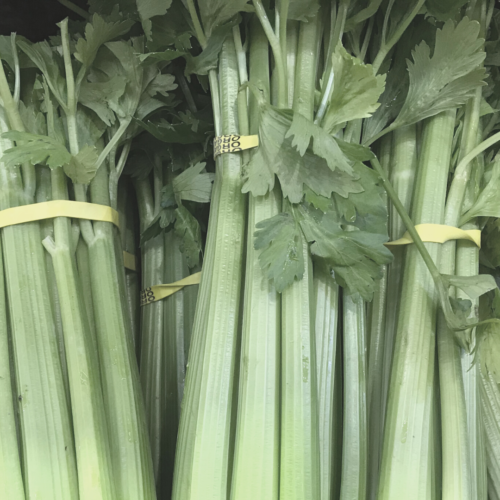
Fermented Celery
Equipment
- 1 glass jar we use a mason jar
- 1 lid for the jar
Ingredients
- 1 bunch celery
- 1 quart filtered water
- 4 tsp sea salt
- lemon juice optional, but boasts its own gut health and/or general health properties
- red pepper flakes optional, but boasts its own gut health and/or general health properties
- red onion optional, but boasts its own gut health and/or general health properties
- fresh dill optional, but boasts its own gut health and/or general health properties
- black pepper optional, but boasts its own gut health and/or general health properties
Instructions
- Start by mixing 4 teaspoons of salt with your water and mix thoroughly in a large mixing bowl to create a brine solution.
- Wash and chop celery to fit inside the jar of choice. There should be one inch or more of water between the top of the jar and the celery stalks.
- Fill the jar with celery- keeping them very close together so that they do not float when brine is added. You want to try and reduce the air pockets that could interfere with the fermentation process!
- Completely cover celery with your brine solution.
- Optional to add your lemon juice, pepper flakes, red onion, fresh dill, and/or black pepper.
- Allow to rest for a couple of days in a room cool area with no direct sunlight. A pantry or cabinet is a great place for storing.
- Open the jar slightly to let out air every other day or every day after 2-3 days. This process is also known as “burping” the jar.
- Continue to ferment for a total of 5-7 days. You can ferment longer or a bit shorter depending on taste preference.
- Refrigerate the jar and enjoy your nutrient packed snack.
A little science
Fermentation is a type of metabolism that depends on sugar rather than oxygen to create energy.
Fungi, yeast, and bacteria all utilize this process to fuel their cells in environments with little to no oxygen.
Many different strains can undergo this process, but one of the most common are Lactobacillus bacteria.
These bacteria and other “good bacteria” ferment in an anaerobic, salty environment, which is why we utilize a combination of salt and water in our recipe.
Salt has special properties that allow it to simultaneously kill off bad bacteria while letting the beneficial bacteria grow and reproduce.
It allows a controlled environment for Lactobacillus bacteria to grow and produce lactic acid, carbon dioxide, and ethanol.
These byproducts turn the solution acidic; this is the tangy taste that is known to all who commonly eat fermented food such as pickles or sauerkraut.
The acidic levels also help further prevent unwanted pathogens and bacteria from growing in your food, keeping them safe and full of your healthy probiotics.
“Burping” your jar
Since the lactobacillus bacteria produce carbon dioxide as a byproduct, the fermentation jar can get a little bit “gassy.”
It is necessary to tightly pack the celery to prevent oxygen from collecting and causing oxidative damage to the bacteria and celery.
All you have to do is unscrew the lid to air out the jar every other day until the fermentation process is complete.
Or, if you are using the special airlock system, simply pump out air every other day.
Health benefits of fermentation
The fermentation process provides us with tons of good bacteria that colonize in our intestines and help encourage a healthy gut microbiome.
Our gut microbiome- for those who are unfamiliar- is simply the collection of organisms living within our digestive tract, composed of fun critters such as yeast, bacteria, and microbes.
All of these are good in moderation but can easily spiral out of control.
Fermented food provides beneficial bacteria that can colonize and overpower the “bad guys” in our guts, protecting us from unwanted gut symptoms.
The bacteria from the fermentation process also help produce vitamins necessary for our health.
In particular, fermentation helps produce water-soluble B vitamins that help with many functions such as iron absorption and converting food into energy.
These small bacterial strains also help break down food and prevent uncomfortable digestive symptoms associated with a less diverse gut microbiome.
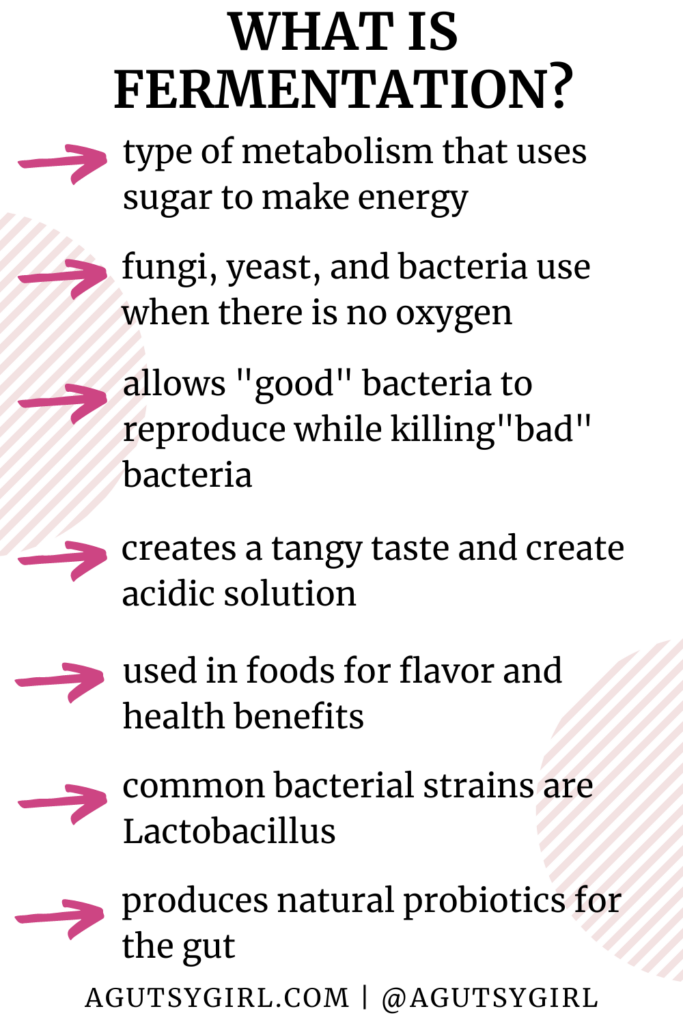
Health benefits of celery
Celery has many health benefits for the entire body.
It has a lot of fiber relative to its water content, which helps to keep the digestive tract regular and operating smoothly.
In addition, celery also contains a lot of antioxidants, which help prevent oxygen from breaking down our hurting your body’s cells.
Some of these include vitamin C and common phytochemicals, or nutrients found in plants.
Celery also helps with blood pressure maintenance with its phytochemical content. One particular phytochemical, phthalide, helps to decrease stress on blood vessel walls, preventing high stress and blood pressure.
Celery also contains many notable vitamins and minerals, many of which help in chemical reactions that keep our body operating correctly.
These include:
- Vitamin A- immune system health, reproductive health, growth
- Vitamin C- helps with the calcium stores in our body, which help keep our teeth and bones strong
- Vitamin K- helps with bone health and blood clotting
- Folate- assists with iron absorption
- Potassium- key for muscle function and nervous system
These vitamins help keep everything from our bones to our reproductive organs in good standing, and able to support the wellness of our entire body system.
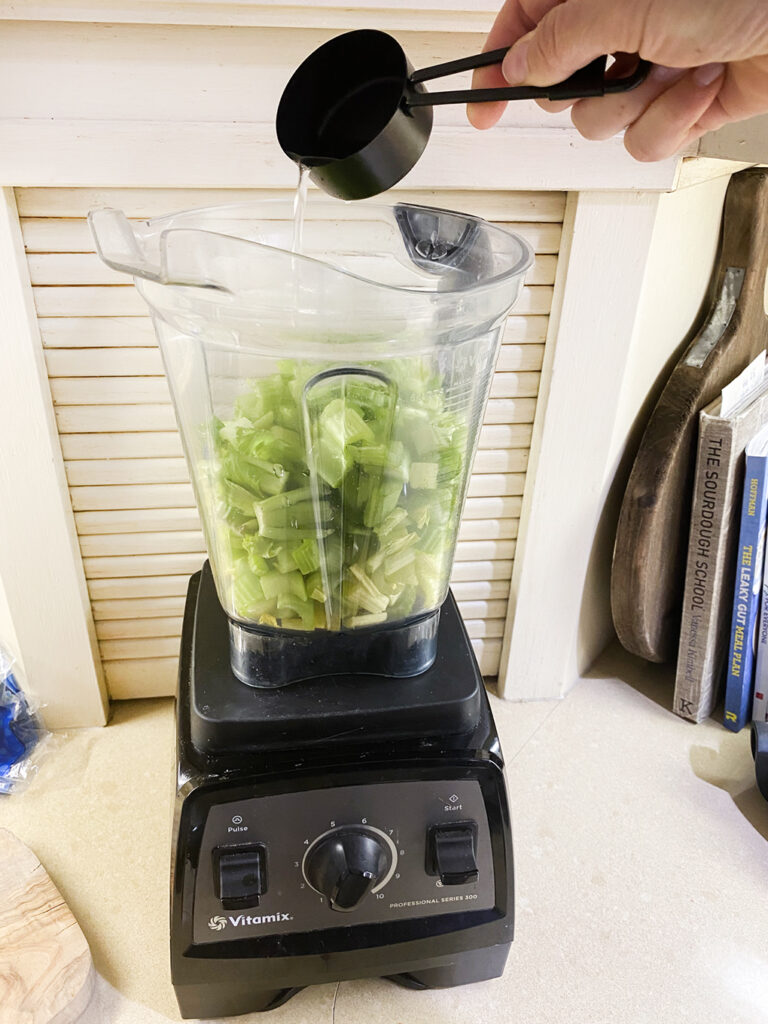
How to use fermented celery?
Fermented celery is a great option on its own as a quick snack, or added into other recipes for added nutrient benefits.
It can be used in chicken salad, added to a salad, juiced to make celery juice, or simply paired with another fermented vegetable for a bacteria-rich snack!
As a whole, fermented celery is a great example of a probiotic food that can help support overall gut healing and whole-body wellness.
It is an incredibly easy way to bump up the diversity of your gut microbiome and encourage a healthy digestive system.
Sources: HERE, HERE, HERE, HERE, HERE, and HERE.
If you liked this post on Fermented Celery, you might also enjoy:
- Fermented Essentials {What to Know + Items Needed}
- Is Sourdough Bread Vegan (Your Ultimate Guide)
- Does Apple Cider Vinegar Make You Poop
If simple concoctions like this are interesting to you, then you’ll love my book, A Gutsy Girl’s Bible: a 21-day approach to healing the gut. In it, you’ll find 100+ Creations. Grab your copy on Amazon HERE.
Or, have this book at your fingertips instantly by downloading the PDF now.
Xox,
SKH
Janie Greene is

![Self Healing [through healing letters]](https://agutsygirl.com/wp-content/uploads/2021/01/writing-letters-healing-featured-agutsygirl.com_.png)

![Vinaigrette Ratio [homemade salad dressing]](https://agutsygirl.com/wp-content/uploads/2011/06/salad-dressing-featured-agutsygirl.com_.png)


